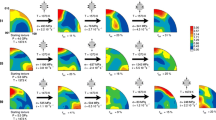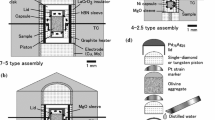Abstract
A marked anisotropy in viscosity develops in Earth’s mantle as deformation strongly aligns the crystallographic axes of the individual grains that comprise the rocks. On the basis of geodynamic simulations, processes significantly affected by viscous anisotropy include post-glacial rebound1,2, foundering of lithosphere3 and melt production above subduction zones4. However, an estimate of the magnitude of viscous anisotropy based on the results of deformation experiments on single crystals5 differs by three orders of magnitude from that obtained by grain-scale numerical models of deforming aggregates with strong crystallographic alignment6,7,8. Complicating matters, recent experiments indicate that deformation of the uppermost mantle is dominated by dislocation-accommodated grain-boundary sliding9, a mechanism not activated in experiments on single crystals and not included in numerical models. Here, using direct measurements of the viscous anisotropy of highly deformed polycrystalline olivine, we demonstrate a significant directional dependence of viscosity. Specifically, shear viscosities measured in high-strain torsion experiments are 15 times smaller than normal viscosities measured in subsequent tension tests performed parallel to the torsion axis. This anisotropy is approximately an order of magnitude larger than that predicted by grain-scale simulations. These results indicate that dislocation-accommodated grain-boundary sliding produces an appreciable anisotropy in rock viscosity. We propose that crystallographic alignment imparts viscous anisotropy because the rate of deformation is limited by the movement of dislocations through the interiors of the crystallographically aligned grains. The maximum degree of anisotropy is reached at geologically low shear strain (of about ten) such that deforming regions of the upper mantle will exhibit significant viscous anisotropy.



Similar content being viewed by others
References
Christensen, U. R. Some geodynamical effects of anisotropic viscosity. Geophys. J. R. Astron. Soc. 91, 711–736 (1987)
Han, D. & Wahr, J. An analysis of anisotropic mantle viscosity, and its possible effects on post-glacial rebound. Phys. Earth Planet. Inter. 102, 33–50 (1997)
Lev, E. & Hager, B. H. Rayleigh-Taylor instabilities with anisotropic lithospheric viscosity. Geophys. J. Int. 173, 806–814 (2008)
Lev, E. & Hager, B. H. Anisotropic viscosity changes subduction zone thermal structure. Geophys. Geochem. Geosyst. 12, Q04009 (2011)
Durham, W. B. &. Goetze, C. Plastic flow of oriented single crystals of olivine 1. Mechanical data. J. Geophys. Res. 82, 5737–5753 (1977)
Castelnau, O., Blackman, D. K., Lebensohn, R. & Castañeda, P. P. Micromechanical modeling of the viscoplastic behavior of olivine. J. Geophys. Res.. 113, B09202, http://dx.doi.org/10.1029/2007JB005444 (2008)
Knoll, M., Tommasi, A., Logé, R. E. & Signorelli, J. W. A multiscale approach to model the anisotropic deformation of lithospheric plates. Geochem. Geophys. Geosyst. 10, Q08009 (2009)
Tommasi, A. et al. Structural reactivation in plate tectonics controlled by olivine crystal anisotropy. Nature Geosci. 2, 423–427 (2009)
Hansen, L. N., Zimmerman, M. E. & Kohlstedt, D. L. The influence of microstructure on deformation of olivine in the grain-boundary sliding regime. J. Geophys. Res.. 117, B09201, http://dx.doi.org/10.1029/2012JB009305 (2012)
Honda, S. Strong anisotropic flow in a finely layered asthenosphere. Geophys. Res. Lett. 13, 1454–1457 (1986)
Vauchez, A., Tommasi, A. & Barruol, G. Rheological heterogeneity, mechanical anisotropy and deformation of the continental lithosphere. Tectonophysics 296, 61–86 (1998)
Tommasi, A., Mainprice, D., Canova, G. & Chastel, Y. Viscoplastic self-consistent and equilibrium-based modeling of olivine lattice preferred orientations: implications for the upper mantle seismic anisotropy. J. Geophys. Res. 105, 7893–7908 (2000)
Castelnau, O., Blackman, D. K. & Becker, T. W. Numerical simulations of texture development and associated rheological anisotropy in regions of complex mantle flow. Geophys. Res. Lett.. 36, L12304, http://dx.doi.org/10.1029/2009GL038027 (2009)
Hansen, L. N., Zimmerman, M. E. & Kohlstedt, D. L. Grain-boundary sliding in San Carlos olivine: flow-law parameters and crystallographic-preferred orientation. J. Geophys. Res.. 116, B08201, http://dx.doi.org/10.1029/2011JB008220 (2011)
Zhang, S. & Karato, S. Lattice preferred orientation of olivine aggregates deformed in simple shear. Nature 375, 774–777 (1995)
Bystricky, M., Kunze, K., Burlini, L. & Burg, J. P. High shear strain of olivine aggregates; rheological and seismic consequences. Science 290, 1564–1567 (2000)
Paterson, M. S. & Olgaard, D. L. Rock deformation tests to large shear strains in torsion. J. Struct. Geol. 22, 1341–1358 (2000)
Zhang, S., Karato, S., Fitzgerald, J., Faul, U. H. & Zhou, Y. Simple shear deformation of olivine aggregates. Tectonophysics 316, 133–152 (2000)
Karato, S., Jung, H., Katayama, I. & Skemer, P. Geodynamic significance of seismic anisotropy of the upper mantle: new insights from laboratory studies. Annu. Rev. Earth Planet. Sci. 36, 59–95 (2008)
Skemer, P., Katayama, I., Jiang, Z. & Karato, S. The misorientation index: development of a new method for calculating the strength of lattice-preferred orientation. Tectonophysics 411, 157–167 (2005)
Launeau, P. & Cruden, A. R. Magmatic fabric acquisition mechanisms in a syenite; results of a combined anisotropy of magnetic susceptibility and image analysis study. J. Geophys. Res. 103, 5067–5089 (1998)
Bricknell, R. H. & Edington, J. W. Mechanical anisotropy and deformation mechanisms in an Al-Cu-Zr superplastic alloy. Acta Metall. 27, 1313–1318 (1979)
Barnett, M. R., Ghaderi, A., Sabirov, I. & Hutchinson, B. Role of grain boundary sliding in the anisotropy of magnesium alloys. Scr. Mater. 61, 277–280 (2009)
Platt, J. P. & Behr, W. M. Grainsize evolution in ductile shear zones: implications for strain localization and the strength of the lithosphere. J. Struct. Geol. 33, 537–550 (2011)
Podolefsky, N. S., Zhong, S. & McNamara, A. K. The anisotropic and rheological structure of the oceanic upper mantle from a simple model of plate shear. Geophys. J. Int. 158, 287–296 (2004)
Behn, M. D., Hirth, G. & Elsenbeck, J. R. Implications of grain size evolution on the seismic structure of the oceanic upper mantle. Earth Planet. Sci. Lett. 282, 178–189 (2009)
Cordier, P., Amodeo, J. & Carrez, P. Modelling the rheology of MgO under Earth’s mantle pressure, temperature and strain rates. Nature 481, 177–180 (2012)
Becker, T. W. & Kawakatsu, H. On the role of anisotropic viscosity for plate-scale flow. Geophys. Res. Lett.. 38, L17307, http://dx.doi.org/10.1029/2011GL048584 (2011)
Raterron, P., Girard, J. & Chen, J. Activities of olivine slip systems in the upper mantle. Phys. Earth Planet. Inter. 200–201, 105–112 (2012)
Paterson, M. S. in The Brittle Ductile Transition in Rocks (eds Duba, A. G., Durham, W. B., Handin, J. W. & Wang, H. F. ) 187–194 (Geophys. Monogr. Ser. Vol. 56, American Geophysical Union, 1990)
Acknowledgements
This work was supported by NSF grant EAR1214876. Parts of this work were carried out in the Institute of Technology Characterization Facility, University of Minnesota, which receives partial support from NSF through the NNIN programme. We thank T. Becker, B. Holtzman and A. Tommasi for discussions.
Author information
Authors and Affiliations
Contributions
All authors discussed experiment design. L.N.H. conducted sample preparation, deformation experiments, and microstructural and mechanical analyses. M.E.Z. aided in sample preparation and deformation experiments. L.N.H. wrote the initial draft of the manuscript. All authors discussed the results and commented on the manuscript.
Corresponding author
Ethics declarations
Competing interests
The authors declare no competing financial interests.
Supplementary information
Supplementary Information
This file contains a Supplementary Discussion and Data, Supplementary Figures 1-2 and Supplementary Tables 1-2. (PDF 146 kb)
Rights and permissions
About this article
Cite this article
Hansen, L., Zimmerman, M. & Kohlstedt, D. Laboratory measurements of the viscous anisotropy of olivine aggregates. Nature 492, 415–418 (2012). https://doi.org/10.1038/nature11671
Received:
Accepted:
Published:
Issue Date:
DOI: https://doi.org/10.1038/nature11671
- Springer Nature Limited
This article is cited by
-
The structure and composition of olivine grain boundaries: 40 years of studies, status and current developments
Physics and Chemistry of Minerals (2018)
-
Crystal preferred orientations of olivine, orthopyroxene, serpentine, chlorite, and amphibole, and implications for seismic anisotropy in subduction zones: a review
Geosciences Journal (2017)
-
Textures in deforming forsterite aggregates up to 8 GPa and 1673 K
Physics and Chemistry of Minerals (2016)
-
Synthesis of crystallographically oriented olivine aggregates using colloidal processing in a strong magnetic field
Physics and Chemistry of Minerals (2016)





